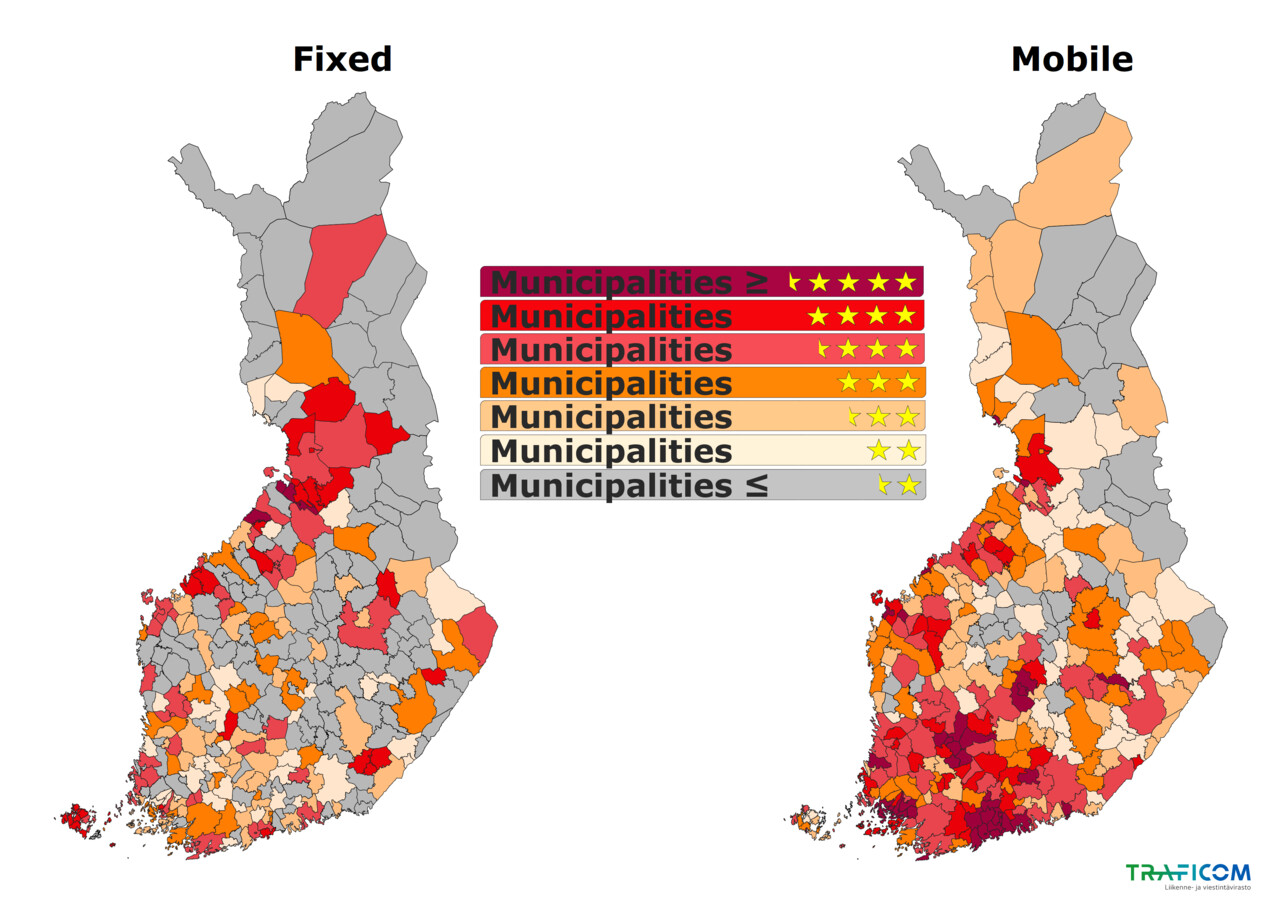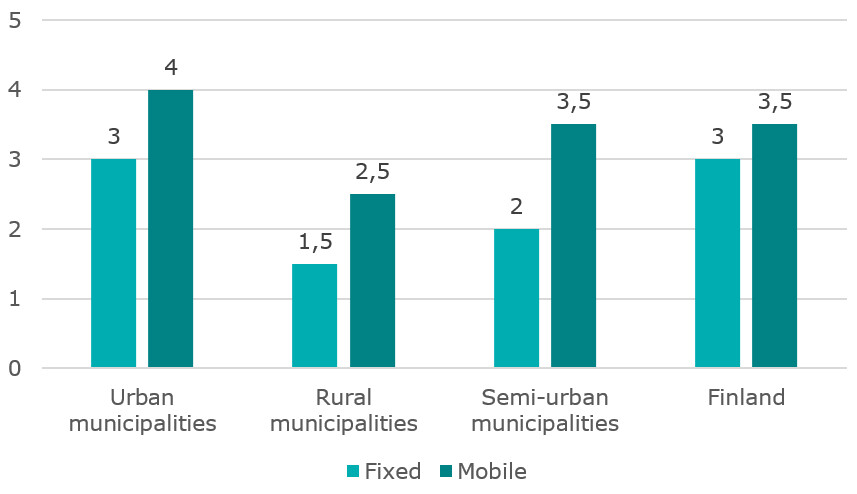In Finland, digitalisation is progressing at different speeds in different geographical areas. In cities and urban municipalities, both optical fibre and mobile high-speed connections are readily available. However, the Finnish Transport and Communications Agency Traficom’s municipality-specific broadband ratings indicate that municipalities’ own activity in building optical fibre networks plays a part in the performance of sparsely populated municipalities as well. In many municipalities, broadband networks are under constant development, with both fixed broadband and mobile broadband ratings improving as the building of optical fibre networks progresses and 5G networks continue to expand.
Traficom’s broadband ratings measure the building and deployment of digital infrastructure on a scale of 1 to 5 stars. Based on the latest data, Finland as a whole receives a rating of 3 stars for fixed broadband and 3.5 stars for mobile broadband. However, there are significant differences between municipalities in the coverage and use of broadband networks – some municipalities receive a higher rating for mobile broadband, while others receive a higher rating for fixed broadband. The calculation of the ratings is based on data collected from telecommunications operators describing the situation at the end of 2021.
“The aim of the municipality-specific broadband ratings is to help us illustrate and monitor regional differences in the quality and use of communications networks. The ratings are calculated taking into account digital needs in the near future as well,” says Communications Market Specialist Marja Heinonen. Because of this, the only way for a municipality to receive a full 5-star rating for fixed broadband would be for all the households of the municipality to have fixed broadband connections with download speeds of at least 100 Mbps in use. For mobile broadband, a 5-star rating can be achieved if the municipality has comprehensive road coverage providing 100 Mbps speeds in ideal conditions and extensive 300 Mbps household coverage.
Fixed connections improving – several municipalities increased their ratings
Based on the data from 2021, a total of 33 municipalities received a fixed broadband rating of at least 4 stars. The highest-rated municipalities were Liminka, Lumijoki and Pyhäjoki at 4.5 stars. All three are located in the North Ostrobothnia region, which has several active co-operatives promoting the building of municipalities’ optical fibre networks. The highest-rated major cities were Helsinki and Tampere, which both received a rating of 4 stars.
Many municipalities improved their ratings compared to the previous year, with 13 municipalities increasing their rating by at least one whole star. Municipalities that improved their fixed broadband rating in particular included Akaa, Haapajärvi, Isokyrö, Maalahti and Siikalatva.
17 municipalities with 5-star mobile networks
The mobile broadband ratings are calculated taking into account that many households in Finland use the mobile network as their only internet connection and that, due to the fluctuating quality of mobile connections, the maximum speed of mobile broadband connections must be higher than that of fixed broadband connections for the actual speed to meet the needs of large households as well. In addition to this, the mobile broadband rating takes into account road coverage, as the primary purpose of mobile connections is to enable access to the internet while on the move, when fixed connections cannot be used.
A full 5-star mobile broadband rating was awarded to a total of 17 municipalities. The majority of these municipalities are major cities and surrounding municipalities or other dense population centres. Mobile network coverage is particularly comprehensive in the Uusimaa, Tampere and Turku regions.
Mobile broadband ratings also improved compared to the previous year, with Pietarsaari and Varkaus increasing their mobile broadband ratings by 1.5 stars, for example. “Mobile broadband coverage is improving as a result of the upgrading of 4G equipment and software and the rapid expansion of the 5G network,” summarises Communications Market Specialist Joonas Sotaniemi. “New mobile networks are being built especially in population centres, which is also reflected in the ratings, and there may be significant differences in mobile broadband speeds even within municipalities,” Sotaniemi continues.

Urban-rural divide clearly reflected in both mobile and fixed broadband ratings
Statistics Finland divides the municipalities of Finland into three groups: urban municipalities, semi-urban municipalities and rural municipalities. In accordance with this classification, Traficom calculated a star rating for both fixed broadband and mobile broadband for each of the three groups. Urban municipalities received a mobile broadband rating of 4 stars, which is only natural, seeing as how mobile networks are built first in areas that have the most users. Urban municipalities were also the highest-rated for fixed broadband. Especially in the largest cities, high-speed connections are also available to consumers via cable modems, whereas the building of optical fibre networks is more consistent across different areas instead of being concentrated to urban areas.
The difference between the mobile broadband rating and the fixed broadband rating is highest in semi-urban municipalities. In addition to population centres, mobile networks are built along major transport routes, which goes some way towards explaining the high mobile broadband rating of semi-urban municipalities. Rural municipalities received the lowest ratings for both mobile and fixed broadband. Building high-speed networks in sparsely populated areas is challenging, as is the expansion of the road network when the distances covered are long and the potential use rate of the roads is low.

CALCULATING THE BROADBAND RATINGS
The municipality-specific fixed broadband rating is calculated on a scale of 1–5 stars based on the household availability of fixed broadband connections enabling both current and future services (min. download speed 100 Mbps) and how many high-speed connections consumers have adopted (min. 30 Mbps connections). To reach 5 stars, nearly all households in the municipality must have a 100 Mbps connection in use.
The mobile broadband rating focuses on the main feature of mobile connections, meaning their use outside buildings. In addition, the 300 Mbps coverage is taken into account separately, because the maximum speed of the mobile network can rarely be achieved in practice. This means that the calculation emphasises the coverage of 100 Mbps and 30 Mbps on the road, but it also takes 100 Mbps and 300 Mbps household coverages into account. To reach 5 stars, the municipality must have comprehensive 100 Mbps coverage on the road and extensive 300 Mbps household coverage.
ENQUIRIES
You can find more details in the Monitori service (External link)
The star ratings can also be downloaded as a table (External link) (ods, in Finnish). The table also includes additional information on how the ratings are calculated.
Information on the availability of fixed broadband (External link) and the coverage of mobile broadband (External link) by municipality and region in 2021.
Statistics Finland’s statistical grouping of municipalities (External link)
Previously published news on the star rating:
Contact information
Joonas Sotaniemi, Communications Market Specialist, tel. +358 295 390 309, joonas.sotaniemi@traficom.fi
Marja Heinonen, Communications Market Specialist, tel. +358 295 390 306, marja.heinonen@traficom.fi